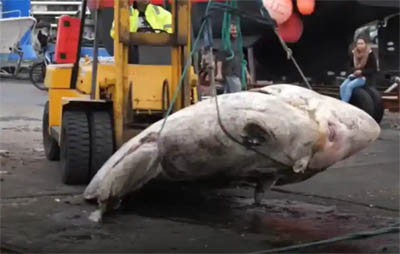Fishermen and boaters saw the huge creature floating near the Azores islands last December
News Desk: dhakamirror.com
In last December, Portuguese scientists learned that fishermen and boaters noticed a dead sunfish in the central North Atlantic. When researchers saw the carcass near Faial Island in the Azores, they nearly couldn’t believe it.
Scientists say the bump-head sunfish (Mola alexandrini) is the biggest bony fish ever found. The fish weighed 6,050 pounds, 882 pounds more than the previous record-holder, a 5,070 pound sunfish off the coast of Japan in 1996.
A new publication in the Journal of Fish Biology provides more facts about the enormous sunfish found in the Azores last year.
Bony fish are the 29,000 aquatic species with skeletons comprised at least partially of bone, not cartilage.These swimmers range in size from pygmy goby to sunfish. More than 90% of fish are bony, excluding rays, sharks, and other cartilaginous fish.
Sunfish have spherical bodies, dorsal and anal fins, and a peculiar circular rudder called a clavus, says National Geographic. Their rough, gray skin attracts parasites.
Sunfish are clumsy swimmers and can’t fully seal their mouths, which are tiny compared to their bodies. Sunfish eat jellyfish, algae, zooplankton, and small fish.
Massive sunfish near the ocean’s surface are commonly mistaken for sharks. Sunfish are harmless, yet curious.
In 2018, bump-head sunfish became a separate species. They’re connected to Mola mola but twice as heavy.
Scientists in the Azores hauled the giant sunfish to shore and forklifted it. Once the fish was airborne, they weighed it with a crane-suspended cargo scale. They also took measurements and DNA samples.
Scientists couldn’t determine if the huge creature was male or female, but it was 10.67 feet long, 11.78 feet tall, and 2.82 feet wide in the middle.Researchers think the fish is at least 20 years old but can’t be sure.
“It must have been a ruler of the open ocean,” says study author José Nuno Gomes-Pereira.
Scientists buried the fish at Faial Island’s Natural Park after examining it. Scientists found a wound containing red boat paint on the dead animal. A vessel accident may have contributed to the sunfish’s demise, but it may have happened after it died.
The giant fish proves that the oceans can still support such a behemoth. Human activities like climate change may change that.
“Big fish are rare due to overfishing and habitat destruction,” says Kory Evans, a fish biologist at Rice University who wasn’t involved in the study.
– Input from Smithsonian was used in this article




